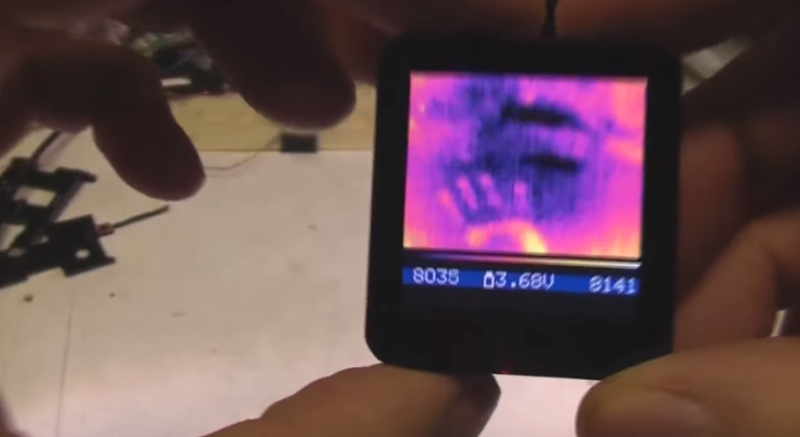[Mike Harrison], the mastermind behind electricstuff.co.uk has just finished reverse engineering the Lepton module found in thermal imaging cameras — he then created his own, and perhaps the world’s smallest thermal camera.
He took apart the Flir One iPhone thermal imaging unit and pulled out the magical part that makes it all possible — the Lepton module. It only has a resolution of 80×60 pixels, but in the world of thermal imaging, it’s pretty decent. You can buy it for $250 (for the module) in order quantities of 1000 straight from Flir.
His blog has all the details about figuring out how to interface with the module, and it is really quite impressive. Once he had it all understood he set out to build it into a small thermal camera. The case is machined out of black acrylic, and an iPod nano screen is used as the display, as 80×60 scales up nicely to the 320×240 resolution of the iPod. A home-brew PCB connects to the module, has a voltage regulator and charging circuit for the lithium ion battery — which is then connected to a prototype iPod nano PCB with some of the features removed — he says it was a nightmare connecting it all, and we don’t blame him, that’s some serious hacking skill!
And if you’re curious as to how he got the Lepton module out of the Flir One…
And then how he managed to reverse engineer it in order to build his own camera…
Anyway, if you happen to be one of the lucky few who has a real Flir camera, check out this $40 lens hack to upgrade its clarity!

















I was looking at getting one of those iPhone adapters just yesterday – alas – it is only good to 100C. I was thinking it might be intentional crippling as to not compete with their more spendy units. Any hope of getting it working beyond 100C?
mike = god
@3DTOPO: The Hema-Imager on Kickstarter aims to be an inexpensive thermal imager with a range of -20C to 220C, it has a slightly lower resolution than the FLIR ONE, though (64×62).
https://www.kickstarter.com/projects/ebeall/hemaimager-accessible-thermal-imaging-for-smart-de
Unfortunately it seems the Kickstarter will not reach its goal, but they will probably try again
Now we just need to make a quantity order
at $250 a pop for the parts with 1000 minimum order, you’re going to be waiting for a while.
Hardly. There are easily 1000 people who’d want one of these for £200 ($350 say).
Then they can just buy the unit for the iPhone and grab the sensor as $350US is what they are selling for around here.
Here is the place you can go buy a module from in single quantity.
https://groupgets.com/campaigns/27-flir-lepton-thermal-imager-batch-1
Wow man….wow. Well done.
Reading the Lepton datasheet is very interesting. It makes a clear point that the framerate is <9Hz, so it is "exportable". This suggests maybe that the framerate is intentionally (and so artificially?) limited (to "8.6Hz" apparently) to make it qualify as exportable.
So, if it is artificially limited, may it be possible for a firmware hack to remove this limit? Hmmm.
AIUI the Lepton has internal FW so they probably could do a different (export controlled) version with higher FR, but may also need a bigger lens.
I only scanned the videos briefly, with sound off. But one thing I saw was was a caption suggesting that by overclocking the whole module, frame rates up to 12hz were achieved before the temperature of the module got too scary to proceed further.
Wow, nice work, p*ssyface (i.e, Predator) would be proud.
Damn it now I want to put a thermal camera in my robotics project and start playing with computer vision. Under the assumption that the thermal data would be slightly easier to parse and separate environment from (non cold blooded) living obstacles (to avoid).
So would that be a Flir mini or Flir nano?
Where can I buy this!!! Seriously though, that is pretty cool. Now if only he could make one that visualized all of the electromagnetic spectrum.
Far out hack, but duplicating it for myself, wouldn’t be in my budget. Not complaining, just stating the current reality.
https://www.kickstarter.com/projects/andyrawson/ir-blue-thermal-imaging-smartphone-accessory
no icrap.